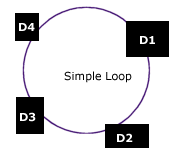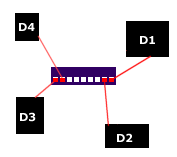|
Fibre Channel : Arbitrated Loop
Fibre
Channel (FC) architecture offers three topologies for
network design: point-to-point, Arbitrated Loop, and Switched
Fabric. All are based on high throughput speeds, with
effective 100MB per second throughput in half-duplex mode
and up to 200 megabyte in full duplex mode.
 Arbitrated
loops were originally designed to connect multiple devices
in a loop similar to the concept used by Token Ring. These
multiple devices created an extended ring topology. This
configuration was also vulnerable to the same issues that
surfaced in point-to-point LAN topologies. A break anywhere
along the point-to-point chain would bring down the entire
segment and would be very difficult to troubleshoot. In
the diagram, if any of the devices connected to the loop,
such as D1, failed, then the loop would be broken and
access to any other devices would terminate. Arbitrated
loops were originally designed to connect multiple devices
in a loop similar to the concept used by Token Ring. These
multiple devices created an extended ring topology. This
configuration was also vulnerable to the same issues that
surfaced in point-to-point LAN topologies. A break anywhere
along the point-to-point chain would bring down the entire
segment and would be very difficult to troubleshoot. In
the diagram, if any of the devices connected to the loop,
such as D1, failed, then the loop would be broken and
access to any other devices would terminate.
To
overcome this limitation, hubs can be used within the
loop to create a physical star topology out of the logical
loop in the same way that an Ethernet hub creates a star
from the logical network loop.

With the addition of the Fibre Channel hub, the connection
is now more reliable. If device D1 now fails, a connection
with D2, D3 and D4 is still available. The loop is still
operating on the same principles as the simple loop above
but the devices are simply connected via a hub instead
of directly betwen each other.
This
continuity is provided by utilising a by-pass circuit
at each port on the hub to prevent the malfunctioning
node from having a cascading effect on the other ports.
The devices themselves may be a combination of storage
systems, RAID arrays, servers, or any other FC enabled
device.
The
HBA and the storage fibre port must support the FC-AL
protocol to participate in an FC-AL configuration.
Fibre
Channel hubs & switches series provide status and
diagnostic LEDs at each port and offer a range of sophisticated
loop integrity features and SNMP management.
|